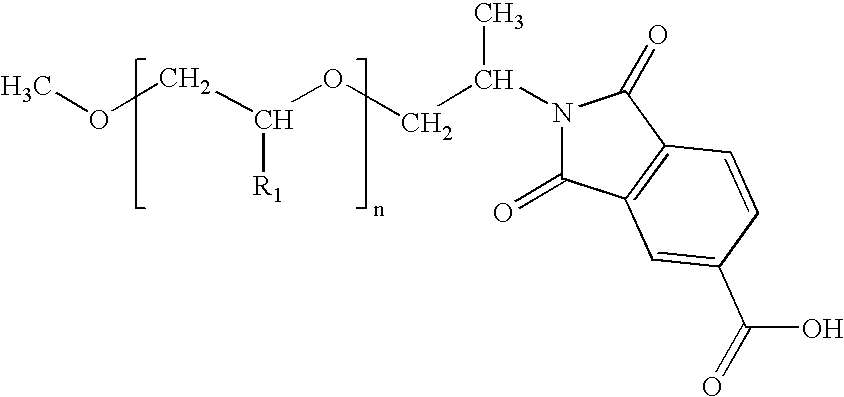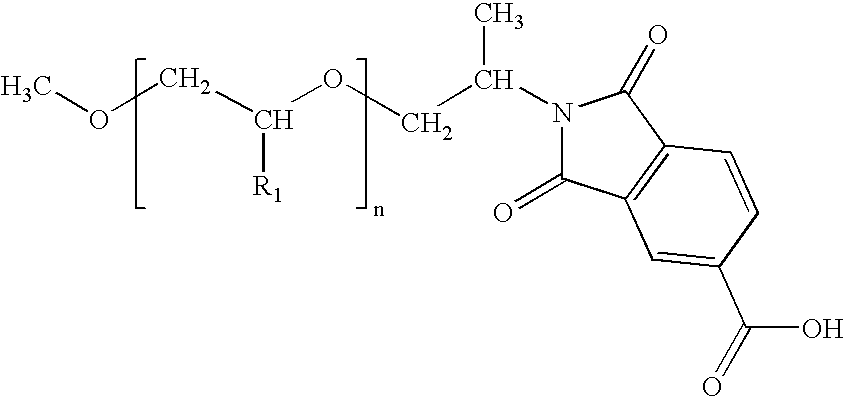Polymeric dispersant
a technology of polymer dispersant and polymer, applied in the field of polymer dispersant, can solve the problems of poor printing quality, affecting the quality of printing ink, and affecting so as to improve the gloss of printing ink composition and reduce the viscosity
- Summary
- Abstract
- Description
- Claims
- Application Information
AI Technical Summary
Benefits of technology
Problems solved by technology
Method used
Image
Examples
example 1
[0016] Polyoxyalkene amine (200 parts, XTJ-507 from Huntsman Chemicals Austin, Tex.) was mixed and stirred with liquid amine 1,2,4-benzenetricarboxylic anhydride (20.1 parts, from Aldrich Chemical Company of Milwaukee, Wisconsin) and heated to 120° C. for about 2 hours while the solid reactant slowly dissolved. The temperature of the mixture was raised to 160° C., maintained for one hour and then cooled slowly to room temperature. The reaction product was a golden yellow liquid having a viscosity of 1990 cPs (measured by Brookfield viscometer spindle #3 at room temperature), an amine number of 0, and acid number of 29.4.
example 2
[0017] Two Ultra Violet Curable printing inks were formulated; one using the polymeric dispersant of Example 1 (Ink 2A) and the other without a dispersant (Ink 2B). The inks were formulated as set forth in Table 1 below:
TABLE 1COMPONENTINK 2AINK 2BExperimental Dispersant of Example 12%0%Pigment Red 52:1 (Bon Red 218-0640)19%19%Cyracure 6105 (UV curable ink vehicle)44%45%Cyracure 6974 (UV initiator)2%2%Cyracure 6990 (UV initiator)2%2%Limonene Dioxide31%32%Viscosity (centipoise at room temperature)622010,000TOTAL100%100%
[0018] The inks were tested for viscosity by placing them in a Brookfield viscometer Spindle #4 (manufactured by Brookfield of Middleboro, Mass.) and measured at 60 revolutions per minute and at 23° C.
example 3
[0019] Two high pigment content dispersions suitable for use in solvent packaging ink compositions were formulated; one using the polymeric dispersant of Example 1 (Ink 3A) and the other without a dispersant (Ink 3B). The inks were formulated as set forth in Table 2 below:
TABLE 2COMPONENTINK 3AINK 3BExperimental Dispersant of Example 1 2 g 0Pigment Red 52:1 (Bon Red 218-0640) 16 g 16 g40% Nitrocellulose Resin Ink Vehicle 28 g 28 gIsopropyl Acetate 52 g 53 gTall oil Fatty Acid 1 g 1 gEpoxidized vegetable oil 1 g 1 gTOTAL100 g100 g
[0020] The inks were then tested for viscosity by placing them first in a Brookfield viscometer Spindle #4 at 12 rpm and second in a Brookfield viscometer Spindle #4 at 30 rpm (both at room temperature or 23° C.). The results are set forth in Table 3 below:
TABLE 3INK 3AINK 3BViscosity measured at 12 rmp350 centipoise500 centipoiseViscosity measured at 30 rmp260 centipoise340 centipoise
PUM
| Property | Measurement | Unit |
|---|---|---|
| Fraction | aaaaa | aaaaa |
| Fraction | aaaaa | aaaaa |
| Fraction | aaaaa | aaaaa |
Abstract
Description
Claims
Application Information
 Login to View More
Login to View More - R&D
- Intellectual Property
- Life Sciences
- Materials
- Tech Scout
- Unparalleled Data Quality
- Higher Quality Content
- 60% Fewer Hallucinations
Browse by: Latest US Patents, China's latest patents, Technical Efficacy Thesaurus, Application Domain, Technology Topic, Popular Technical Reports.
© 2025 PatSnap. All rights reserved.Legal|Privacy policy|Modern Slavery Act Transparency Statement|Sitemap|About US| Contact US: help@patsnap.com



